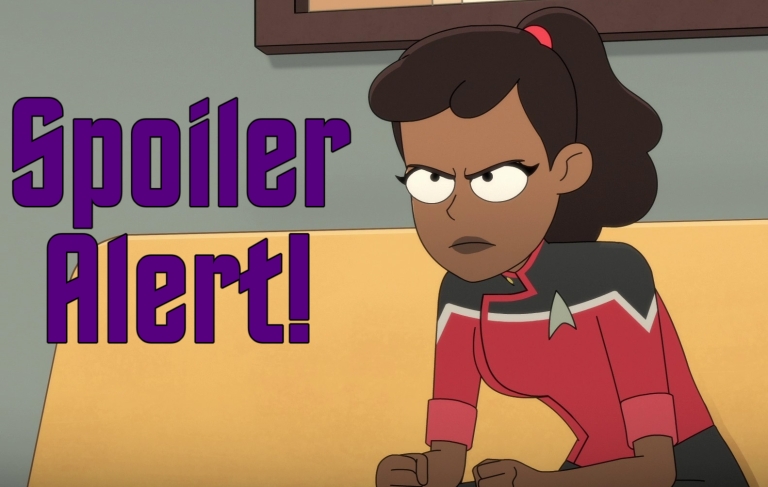
Spoiler Warning: There are spoilers ahead for Star Trek: Discovery Seasons 1-4, Star Trek: Picard Season 1, and for other iterations of the Star Trek franchise.
The Examples was a stunningly good episode. When the season draws to a close, no matter how key storylines are ultimately paid off, we’ll look back and say this was one of the highlights. This week we got three stories rolled into one, all connected to the DMA in different ways, and we also got the introduction of a wonderfully complex new scientist character played by Shawn Doyle.
Before we go any further, I want to continue to call out the corporate nonsense from ViacomCBS that has prevented Star Trek fans from outside of Europe and North America from being able to watch Star Trek: Discovery. ViacomCBS seems to have no interest in Africa, Asia, or even countries and territories like Ireland or Puerto Rico, and the rollout of Paramount+, which continues at what we might generously call a snail’s pace, means nothing to millions of Trekkies all over the world. Discovery has become one of the most-pirated shows in recent weeks – something that’s entirely the fault of ViacomCBS and their decision to pull the show from Netflix.

Let’s set that aside for now and talk about The Examples. We’ll begin with the smaller storyline present in the episode: that of Dr Culber and his emotional struggles. For me, these sequences with Dr Culber – and especially his conversations with Stamets – formed the episode’s real emotional heart. There was a moment toward the end between Captain Burnham and a prisoner named Felix that was also emotional, but we’ve known Dr Culber and followed his story for more than three seasons, so I think it’s natural to feel that this was the one that brought the most emotional weight.
I’m increasingly convinced that Discovery’s main characters each embody a different response to grief and trauma. In Tilly’s case, which we saw come to a head last week, she chose to leave the past behind and strike out on her own. In the case of Stamets we see the workaholic, someone willing to set aside much of his personal life and family commitments and throw himself into his work. The same kind of applies to Captain Burnham, though she also embodies the “protective partner” through her relationship with Book. Book, of course, has shown us the depths of depression and grief. And with Dr Culber we have someone who’s dedicated himself to helping others – even if that comes at his own expense.

The scenes between Stamets and Culber were a complete inversion of what I’d been expecting – and I loved every second of it. After Stamets missed Gray’s incorporation and wasn’t there for Adira in Choose To Live, I’d been expecting Dr Culber to be the one to call him out for overworking himself, telling him he missed something important with his family – and with his friend, as he wasn’t really there for Tilly before she left the ship. But instead we got the reverse of that: it was Stamets who had to tell Dr Culber that he’s been the one overworking himself for the sake of the crew.
This moment was absolutely perfect, and I felt it really drove home just how these two came to fall in love in the first place. Stamets and Culber have been Discovery’s emotional core since the show’s first season, but this was the first time we got this level of insight into what brought them together – and what has kept them together even through all the sci-fi adventures they’ve been on.
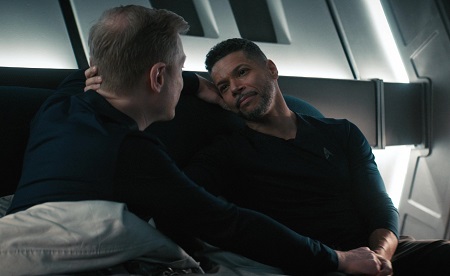
Kovich – or should that be Doctor Kovich? – continues to confound me. Who is this mysterious man? We’ve seen him seemingly working for Starfleet Intelligence in some capacity, working alongside Admiral Vance at or near the top of the organisation, playing a leading role in Starfleet Academy – including being able to appoint teachers simply on his say-so – and now, in The Examples, he appeared to be acting as a counsellor, therapist, and even psychologist for Dr Culber. I wonder if Discovery plans to nail down Kovich at some point in the future – or if he’ll continue to be used in a variety of roles like this, allowing the lack of a clear explanation or background to provide him with an air of mystery and gravitas. It’s hard to deny that it’s working!
Kovich certainly laid some harsh truths on Dr Culber during their very short session together. And I liked that it came back to what happened to him in Season 2; Dr Culber went through an almost unimaginable experience, one that’s bound to leave emotional wounds. Past iterations of Star Trek were pretty bad at following up with characters who went through what should’ve been traumatic events, so it’s cathartic in a sense to see that the franchise is using its serialised format to right that old wrong.

Some of the goings-on at the prison felt a little rushed and a little forced. After discovering the existence of the prisoners and finding out that they weren’t scheduled to be rescued, Captain Burnham and the crew seem to have made no efforts to follow that up. Could they, for example, have located the prison guards who were said to have fled? Or sought out someone else capable of opening the prison? I know it’s a bit nit-picky, but going there in person feels like it should’ve been a last resort.
There was definitely an interesting element to the prison stand-off, though, once we got into the meat of this side of the story. I said last week that Captain Burnham has a “moral certainty” to her; she knows what is the right thing to do. This time she came upon two challenges to that morality – and I think in the way she responded to those challenges, we can see how much she’s grown as a character over the past three-plus seasons.

Captain Burnham wanted to rescue all of the prisoners. She wanted to do so not only for Book’s sake, as he’d been suffering ever since the destruction of his homeworld, but also because she truly believed in her heart that it was the objectively moral thing to do. The prisoners immediately challenged that, with several of them expressing the desire to be left to die rather than return to confinement. There was a bit of a cliché as we were told that one of the prisoners had “stolen food to feed his family,” but other than that this side of the story felt complex and nuanced.
We also got a glimpse at the kind of clashing of cultures that happens out here in the real world. The Akaali – a race that first appeared in Enterprise – have a very different culture to the Federation, perhaps influenced in part by the Emerald Chain. In this case, their ideas of justice, punishment, and imprisonment seem draconian by Federation standards – and Captain Burnham had to deal with that culture shock.

Felix was the most complex of the prisoners, a man who’d killed someone decades earlier and had lived with that regret ever since. Guest star Michael Greyeyes put in a stellar performance as someone not merely resigned to their fate, but actively choosing to embrace it. Felix seemed to truly believe that his punishment or penance for his crime required his own death, and had he survived if the DMA had taken a different path, I believe he would have sought out the Akaali authorities and turned himself in all over again.
His choice was difficult for Book and Burnham, though, who had endeavoured to save all six prisoners. Book appeared to be ready to intervene, saving Felix’s life even if it went against his wishes, but Captain Burnham eventually understood that this was something she had to do. After all the talk earlier in the season about the Kobayashi Maru test and no-win scenarios, here we got to see Captain Burnham confronted with her own small-scale version of that very challenge. She rose to meet it in a way that she would have struggled to in earlier stories.
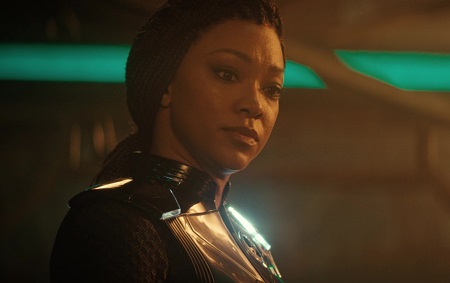
There are many different ways we could read Felix’s story in The Examples. There’s definitely an allegory for imprisonment itself; that prison can have value as a rehabilitative institution. But we can also read Felix’s final choice through a more metaphorical and philosophical lens: it’s a tale about the value of freedom, and the freedom to choose one’s own path and ultimate fate. It’s a story about agency and the right to determine the outcome of one’s own life. Felix could have been “saved,” but doing so would have cost him his freedom in a different way.
This story took what could have been a fairly simple and uninspired plot about rescuing prisoners in a different and unexpected direction, providing some much-needed complexity to Captain Burnham’s side of the episode. It also gave both her and Book an emotional moment toward the end of the episode, with Book in particular believing the decision to leave Felix behind was wrong. And as the audience, we can see both sides of this argument and acknowledge that there’s no objectively right answer. On the one hand, if Felix had been saved he could have found other ways to have meaning in his life or to complete his penance and rehabilitate himself. Giving him that chance, even if it was against his will in that moment, could have paid dividends later. On the other hand, though, Felix was a grown adult of seemingly sound mind, and if this was the choice he freely made, knowing the consequences, does anyone have the right to interfere? It’s a complex story with no easy answer – and this could be a whole essay in itself drawing comparisons with things like the right-to-die movement, suicide, and many more.
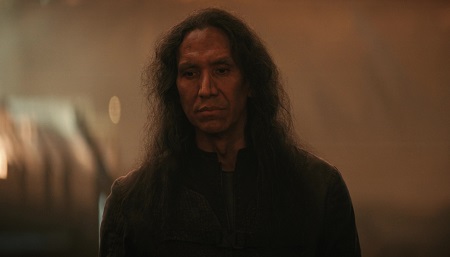
Sonequa Martin-Green played Captain Burnham with real complexity this week, and her performance nailed Burnham’s real struggle with this decision. As recently as the season premiere, Burnham had said to President Rillak that she wasn’t ever willing to leave anyone behind or make this kind of choice; a variation on Captain Kirk’s famous “I don’t believe in no-win scenarios” stance. But something’s changed for Burnham – perhaps the existence of the DMA, or simply the realities of command. This evolution allows her to remain true to herself – she still wants to do the right thing. She just seems willing to consider different perspectives on what is “right,” including those that fall outside of her own interpretation.
So let’s take a look at the biggest revelation in The Examples: the DMA is an artificial creation. This is something I’d been theorising about in one form or another since we first learned of the existence of the anomaly in the first Season 4 teaser trailer earlier in the year, and I don’t think many fans or viewers will have been terribly shocked. A natural disaster angle could’ve worked well for the DMA, presenting Captain Burnham and the crew with a scientific challenge to untangle rather than a villainous adversary to defeat. But that ship has sailed – and really, this is the way I think we all expected Discovery to go with the DMA.

Though this story was great overall, there was one part at the beginning that felt very rushed. After Stamets noticed the DMA disappearing and reappearing, Captain Burnham asked Zora (the ship’s AI) if the DMA could be a natural ocurrence. Zora replied that it couldn’t be, and based seemingly on these two lines alone, the rest of the plot was left to unfold. It just feels far too quick and easy to have gotten a one-line answer from Zora about the nature of the DMA, and I feel it would’ve been nicer to see at least some of the workings that led to that conclusion – perhaps Stamets could’ve said he’d come up with an artificial DMA as a new theory after weeks of work; same result, same short scene, but perhaps a better overall feeling that this wasn’t all based on one very brief analysis.
This second point is really more of a nitpick, but here we go anyway: how did everyone in the galaxy find out that the DMA isn’t a natural phenomenon? If Stamets is leading the charge on this investigation, and he only figured it out with the help of Zora… how did that news get out? Starfleet might’ve wanted to keep a lid on something so explosive, and I can absolutely see someone like President Rillak wanting to keep that news on a need-to-know basis to prevent panic and possible political consequences for the very tenuously-united Federation. Maybe we can excuse it by saying the DMA’s disappearance and reappearance led others to figure it out independently, but again this all happened very quickly at the beginning of the episode. It’s a nitpick, though.

There were references to past iterations of Star Trek – as well as the video game Star Trek Online – on this side of The Examples. Admiral Vance listed the Metrons, who first appeared in The Original Series episode Arena, the Nacene, who constructed the Caretaker’s Array that pulled the USS Voyager into the Delta Quadrant, and the Iconian Empire, who were believed to be extinct during the events of The Next Generation but ultimately appeared in the aforementioned Star Trek Online.
However, at the end of the episode, Ruon Tarka explicitly ruled out all three of these races as being the culprit. So who is Species 10-C? And perhaps a bigger question is this: will the DMA connect back to a past iteration of Star Trek, or will the storyline follow a similar route to the Burn in Season 3 and ultimately turn out to be something altogether new? Part of me wants to say that we wouldn’t have had all of these teases if there wasn’t going to be some big connection and a big reveal that would be meaningful for us as the audience – the Borg, the super-synths from Picard, or something of that nature. But another big part of me is saying “remember the Burn!” and feels certain that we’re going to encounter someone entirely new.

We’ll save the theorising for later, though, because this side of the episode had far more going on than just that! Shawn Doyle arrived as Ruon Tarka, and he played the arrogant scientist exceptionally well. Tarka is a strangely relatable character – I think a lot of us have known someone who’s so incredibly self-assured and who comes across as very rude and even selfish. Tarka, to my surprise I must admit, backed up his arrogance with genuine skill, and by the end of the episode even Stamets seemed to have warmed up to him!
There’s always going to be the temptation to have a character introduced in this fashion ultimately be proven wrong and get some kind of comeuppance, but what makes Tarka such an interesting and nuanced character is that he really did have the scientific skill and know-how to back up what he was saying; all the trash-talking with Stamets actually led somewhere. We can dislike Tarka for his abrasiveness and the way he was rude with Stamets and Saru, but at the end of the day I’m still left with a strong sense that, arrogant or not, he’s someone I want on my side – especially given the nature of the DMA. Pulling off that balance with a brand-new character isn’t going to be easy to get right, yet Discovery pulled it off thanks to a wonderful guest star.

It was very sweet to get multiple mentions of Aurellio this week. Kenneth Mitchell played the character in Season 3, and even though he wasn’t able to appear in person on this occasion, the fact that Discovery went out of its way to reference the character more than once was incredibly sweet. It’s nice to know that Aurellio still exists in the 32nd Century, and that he’s teamed up with the Federation to help solve the mystery of the DMA. Again, I feel better knowing Aurellio is working on this problem too!
The idea that Stamets and Tarka came up with, to create essentially a scaled-down version of the DMA, was a good one, and it worked well on this side of the story. We got to see the two scientists truly working on the problem, tweaking their theories as they went along. This is the scientific method – having a crazy idea and testing it out! Other sci-fi shows would’ve skipped this step and just brought us the conclusion so we could get into more space battles and laser fights, but one thing I’ve always liked about Star Trek is seeing the characters slow down and take their time working on a problem. Neither Stamets nor Tarka could figure out the DMA instantly – and we’ve seen Stamets working on this problem across several episodes now. They seemed to be close to a breakthrough before the experiment had to be shut down – so perhaps a future episode will pick up that dangling story thread.
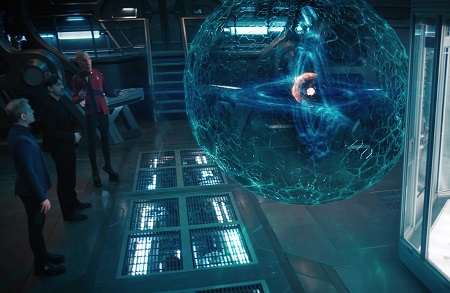
Though she didn’t have many lines, it was great to welcome back Tig Notaro as Reno during this story. Her dry wit cut through what was a very heavy scientific story, and provided some moments of levity that were definitely appreciated. Due to the difficulties of travelling and filming during the pandemic, I already know we aren’t going to get as many Reno appearances as we might want – so it was great to see her on this occasion, and I will definitely savour those light-hearted moments that she brought.
Saru played a guiding role here, ultimately shutting the experiment down as it got too close to the danger zone. But he brought a sense of calmness to the proceedings, something necessary given the hot-headedness of Tarka and Stamets. Seeing him “roar” was definitely something a bit weird… but it was neat nevertheless! Saru was very much back in his element as the senior officer on this side of the story, taking command of the situation but deferring to the scientists as much as possible. Since he underwent the vahar’ai transformation in Season 2, we’ve seen this calmer presentation of Saru. I’ve said this before no doubt, especially during his tenure as captain in Season 3, but he makes for an excellent commander – someone kind of in the mould of Picard as a considerate, level-headed leader.

So that was The Examples. We’re one step closer to figuring out the DMA thanks to Tarka and Stamets’ dangerous experiment – and I hope to see further progress on that storyline soon! The suspense, not knowing who’s responsible for the DMA or what their goal might be is really pulling me in right now – I desperately want the answers to those huge questions!
Some scattered final thoughts: the USS Janeway was a neat callback to Voyager. We’ve had several references to both Enterprise and Voyager so far this season – could either of those be a tease or indication of the direction of the story? The DMA makes an interesting climate change analogy – something ever-present that our heroes all have to work together to overcome. The episode opened by reminding us that Tilly has gone, and Mary Wiseman is no longer credited in the opening credits – so I think her departure from the series is permanent. I had a horrible feeling that something was going to happen to Rhys as he took a leading role in the evacuation… but luckily he lives to fight another day!
I had a fantastic time with The Examples. It advanced the season’s main story in a huge and very significant way, introduced us to a new scientist character who was a ton of fun, and gave us some cathartic emotional moments with Captain Burnham, Book, Dr Culber, and Stamets. All in all, a truly outstanding episode. I’m tearing my hair out trying to figure out who Species 10-C might be – so stay tuned for my next batch of theories for more on that!
Star Trek: Discovery Season 4 is available to stream now on Paramount+ in the United States, Scandinavia, Latin America, and Australia. The show is on Pluto TV in the UK, France, Germany, Italy, and other parts of Western Europe at 9pm on Fridays and Saturdays. Individual episodes or the full season can be purchased on iTunes, Amazon Video, and possibly other platforms in the UK, parts of Europe, and select other countries. The Star Trek franchise – including Discovery and all other properties mentioned above – is the copyright of ViacomCBS. This article contains the thoughts and opinions of one person only and is not intended to cause any offence.

